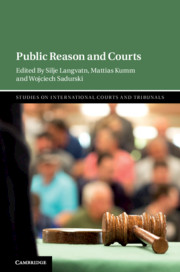Book contents
- Public Reason and Courts
- Studies on International Courts and Tribunals
- Public Reason and Courts
- Copyright page
- Contents
- Contributors
- Preface
- Acknowledgments
- 1 Taking Public Reason to Court: Understanding References to Public Reason in Discussions about Courts and Adjudication
- Part I Public Reason in Constitutional Courts
- Part II Public Reason in International Courts and Tribunals
- 9 European Court of Human Rights in Pursuit of Public Reason? A Study of Lost Opportunities
- 10 The Right to Justification in the Context of Proportionality: A Plea for Determinacy and Stability
- 11 “Going Public”: Reasoning and Justification at the World Trade Court
- Part III Critical Perspective on Public Reason in Courts
- Index
11 - “Going Public”: Reasoning and Justification at the World Trade Court
from Part II - Public Reason in International Courts and Tribunals
Published online by Cambridge University Press: 22 May 2020
- Public Reason and Courts
- Studies on International Courts and Tribunals
- Public Reason and Courts
- Copyright page
- Contents
- Contributors
- Preface
- Acknowledgments
- 1 Taking Public Reason to Court: Understanding References to Public Reason in Discussions about Courts and Adjudication
- Part I Public Reason in Constitutional Courts
- Part II Public Reason in International Courts and Tribunals
- 9 European Court of Human Rights in Pursuit of Public Reason? A Study of Lost Opportunities
- 10 The Right to Justification in the Context of Proportionality: A Plea for Determinacy and Stability
- 11 “Going Public”: Reasoning and Justification at the World Trade Court
- Part III Critical Perspective on Public Reason in Courts
- Index
Summary
As international courts come to play an ever more significant role in global governance, their traditional source of legitimacy embedded in state consent seems no longer sufficient, and additional grounds are needed to sustain their claims for legitimacy. Focusing on the World Trade Organization dispute settlement system (WTO DSS), this chapter recounts the attempts of the adjudicators in a key site of global judicial governance to draw on public reason as one possible way to address their pressing legitimacy gap by ensuring that their own decisions, as well as the states’ decisions they are called upon to review, are the result of reasons and forms of reasoning that can be reasonably understood and accepted to all the subjects affected. In unfolding the WTO DSS’s effort to “go public,” the chapter aims to illustrate the different forms in which the idea of public reason can be said to apply to international courts, as well as to develop a better understanding of the promise and limitations embedded in the concept of public reason as a means for international courts to enhance their legitimacy given their unique features and the pluralistic global setting in which they operate.
Keywords
- Type
- Chapter
- Information
- Public Reason and Courts , pp. 281 - 320Publisher: Cambridge University PressPrint publication year: 2020



